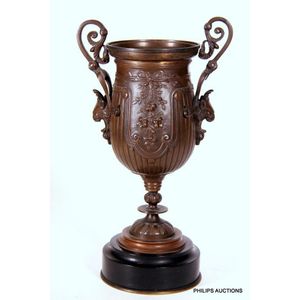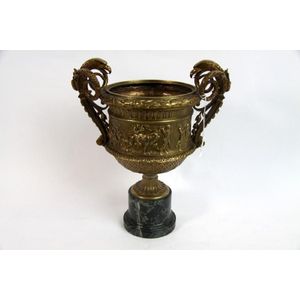Neo-Classical Gilt Bronze Urn by F. Barbedienne
You must be a subscriber, and be logged in to view price and dealer details.
Subscribe Now to view actual auction price for this item
When you subscribe, you have the option of setting the currency in which to display prices to $Au, $US, $NZ or Stg.
- Important - Important is a word used in the antique trade to indicate an object should be ranked above other similar objects, and is therefore more valuable.
The object could be considered important because it is by a famous designer or maker, has been shown at a major exhibition, is of exquisite workmanship, is rare or is a "one-off", was made for an important patron, and so on.
Even further up the pecking order are objects that are described in catalogue descriptions as highly important or extraordinarily important. - Bronze - An alloy of copper and tin, traditionally in the proportions of about 9 parts of copper to 1 part of tin.
The discovery of bronze in Western Asia in the 4th century enabled people to create metal objects which were superior to those previoulsy possible because of its strength and hardness, and it has been used throughout the world for weapons, coins, tools, statuary and other decorative items.
It is very fluid in a molten state, and its hardness, strength when set, and non-corrosive properties makes it most suitable for casting sculpture. - Neo Classical - The period or style, known as "neo-classical", was based on Greek and Roman designs and motifs, and is usually associated with the influence of the four Adam brothers, but principally Robert Adam, the second oldest of the brothers, who were architects and designers, active in the latter half ot the 18th century (1760s to 1790s).
Born in Scotland in 1728, Robert Adam spent time in Italy studying and his designs are influenced by the finds made during the excavation of Pompei.
When he returned to England he became the Court Architect to George III (1738-1820).
In turn, designs by Adam then influenced Hepplewhite.
Neo-classical ornamentation is characterised by use of classical urns, palmettes, mythical creatures such as the sphinx and griffin, ram's heads, swags, scrolling foliage, and use of the Greek key pattern.
This item has been included into following indexes:
Visually similar items

A large neoclassical gilt bronze copy of the Warwick vase, 19th century, after the antique, the Warwick vase having an everted egg and dart decorated rim above a series of eight Bacchic mascarons in high relief, pairs of threaded rope and knot handles, abo

An impressive pair of bronze and brass urns having Bachanalian scene. 33 cm high.

English hallmarked sterling silver Victorian jug with allover floral etched detail. Birmingham, 1863, maker Henry Hyde Aston, height 12.5 cm, weight 179g

A French bronze urn, 19th century, a bell shaped urn with high set bifurcated scrolling handles with roaring lion mounts, the reeded body with shaped panels enclosing pendant floral festoons, above a knopped and turned stem to a spreading black marble base
